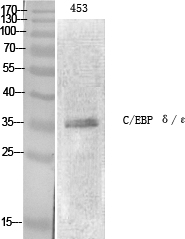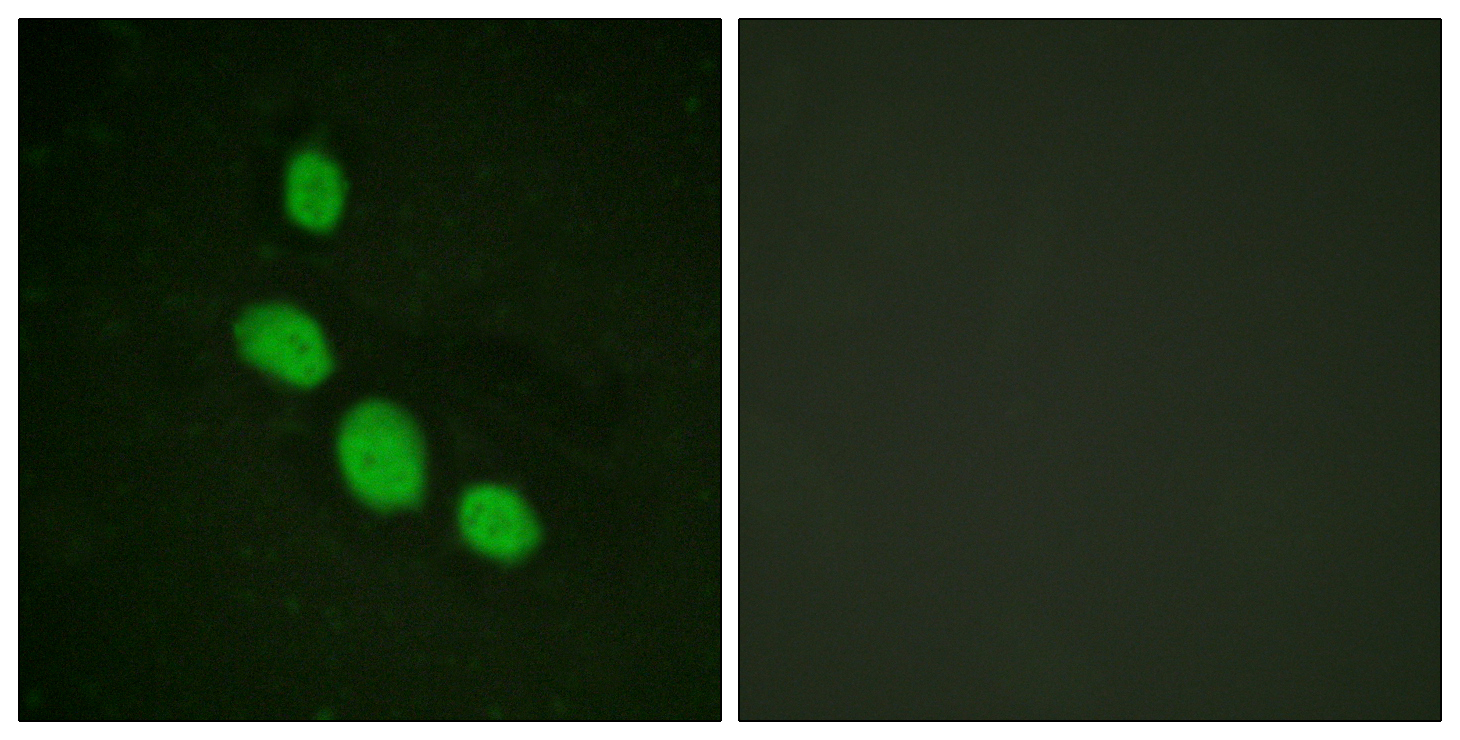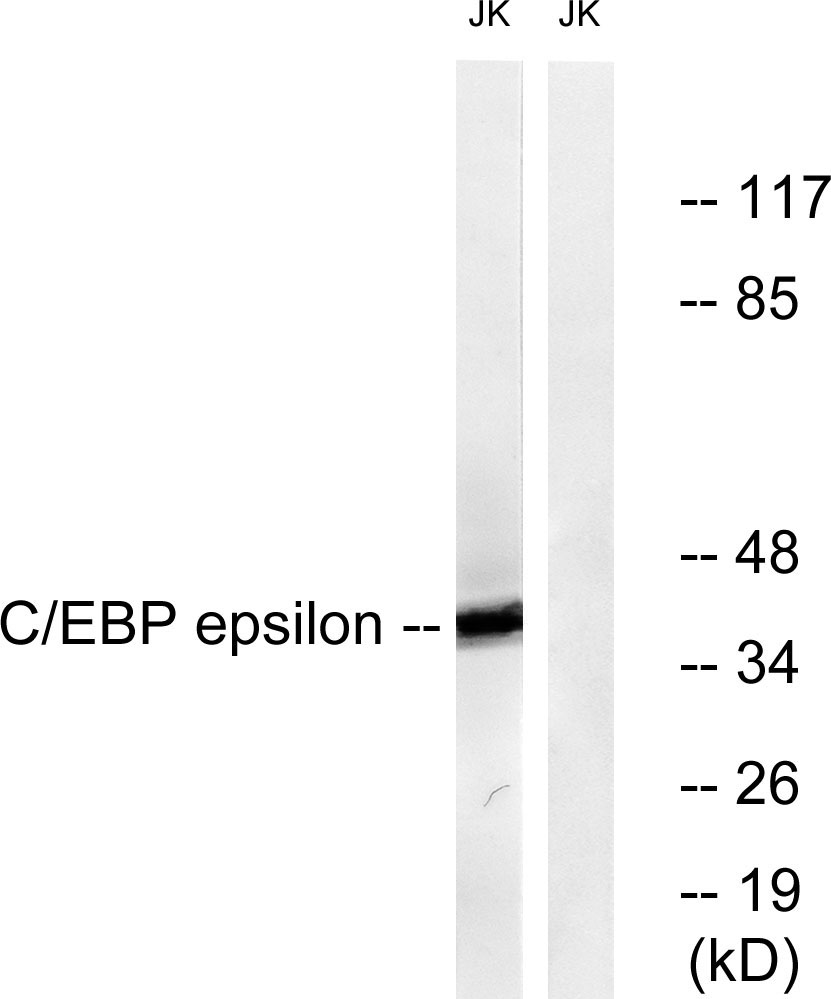C/EBP ε Polyclonal Antibody
- Catalog No.:YT0558
- Applications:WB;IHC;IF;ELISA
- Reactivity:Human;Rat;Mouse;
- Target:
- C/EBP ε
- Fields:
- >>Transcriptional misregulation in cancer;>>Acute myeloid leukemia
- Gene Name:
- CEBPE
- Protein Name:
- CCAAT/enhancer-binding protein epsilon
- Human Gene Id:
- 1053
- Human Swiss Prot No:
- Q15744
- Mouse Swiss Prot No:
- Q6PZD9
- Immunogen:
- The antiserum was produced against synthesized peptide derived from human C/EBP-epsilon. AA range:40-89
- Specificity:
- C/EBP ε Polyclonal Antibody detects endogenous levels of C/EBP ε protein.
- Formulation:
- Liquid in PBS containing 50% glycerol, 0.5% BSA and 0.02% sodium azide.
- Source:
- Polyclonal, Rabbit,IgG
- Dilution:
- WB 1:500 - 1:2000. IHC 1:100 - 1:300. IF 1:200 - 1:1000. ELISA: 1:5000. Not yet tested in other applications.
- Purification:
- The antibody was affinity-purified from rabbit antiserum by affinity-chromatography using epitope-specific immunogen.
- Concentration:
- 1 mg/ml
- Storage Stability:
- -15°C to -25°C/1 year(Do not lower than -25°C)
- Other Name:
- CEBPE;CCAAT/enhancer-binding protein epsilon;C/EBP epsilon
- Observed Band(KD):
- 34kD
- Background:
- The protein encoded by this gene is a bZIP transcription factor which can bind as a homodimer to certain DNA regulatory regions. It can also form heterodimers with the related protein CEBP-delta. The encoded protein may be essential for terminal differentiation and functional maturation of committed granulocyte progenitor cells. Mutations in this gene have been associated with Specific Granule Deficiency, a rare congenital disorder. Multiple variants of this gene have been described, but the full-length nature of only one has been determined. [provided by RefSeq, Jul 2008],
- Function:
- function:C/EBP are DNA-binding proteins that recognize two different motifs: the CCAAT homology common to many promoters and the enhanced core homology common to many enhancers.,online information:CEBPE mutation db,PTM:Phosphorylated.,similarity:Belongs to the bZIP family. C/EBP subfamily.,similarity:Contains 1 bZIP domain.,subunit:Binds DNA as a dimer and can form stable heterodimers with C/EBP delta.,tissue specificity:Strongest expression occurs in promyelocyte and late-myeloblast-like cell lines.,
- Subcellular Location:
- Nucleus .
- Expression:
- Strongest expression occurs in promyelocyte and late-myeloblast-like cell lines.
- June 19-2018
- WESTERN IMMUNOBLOTTING PROTOCOL
- June 19-2018
- IMMUNOHISTOCHEMISTRY-PARAFFIN PROTOCOL
- June 19-2018
- IMMUNOFLUORESCENCE PROTOCOL
- September 08-2020
- FLOW-CYTOMEYRT-PROTOCOL
- May 20-2022
- Cell-Based ELISA│解您多样本WB检测之困扰
- July 13-2018
- CELL-BASED-ELISA-PROTOCOL-FOR-ACETYL-PROTEIN
- July 13-2018
- CELL-BASED-ELISA-PROTOCOL-FOR-PHOSPHO-PROTEIN
- July 13-2018
- Antibody-FAQs
- Products Images

- Western Blot analysis of various cells using C/EBP ε Polyclonal Antibody cells nucleus extracted by Minute TM Cytoplasmic and Nuclear Fractionation kit (SC-003,Inventbiotech,MN,USA).
.jpg)
- Western Blot analysis of Jurkat cells using C/EBP ε Polyclonal Antibody cells nucleus extracted by Minute TM Cytoplasmic and Nuclear Fractionation kit (SC-003,Inventbiotech,MN,USA).

- Immunofluorescence analysis of HeLa cells, using C/EBP-epsilon Antibody. The picture on the right is blocked with the synthesized peptide.

- Immunohistochemistry analysis of paraffin-embedded human brain tissue, using C/EBP-epsilon Antibody. The picture on the right is blocked with the synthesized peptide.

- Western blot analysis of lysates from JurKat cells, treated with Insulin 0.01U/ml 15', using C/EBP-epsilon Antibody. The lane on the right is blocked with the synthesized peptide.



